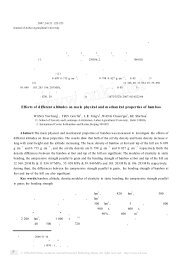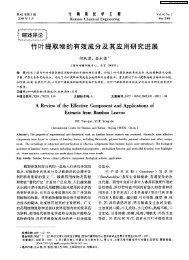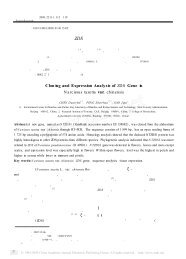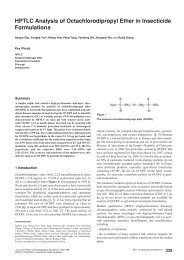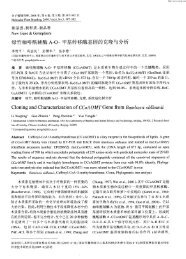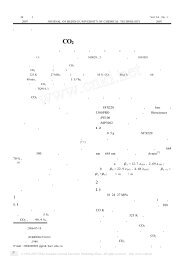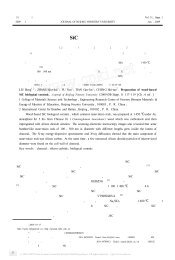SIMCA 法判别分析木材生物腐朽的研究 - ICBR
SIMCA 法判别分析木材生物腐朽的研究 - ICBR
SIMCA 法判别分析木材生物腐朽的研究 - ICBR
Create successful ePaper yourself
Turn your PDF publications into a flip-book with our unique Google optimized e-Paper software.
2 7 , 4 <br />
Vol1 27 ,No1 4 ,pp6862690<br />
2 0 0 7 4 Spectroscopy and Spectral Analysis April , 2007 <br />
<strong>SIMCA</strong> <br />
1 , 1 ,2 3 , 1 , 2<br />
11 , 100091<br />
21 , 100102<br />
, , , <br />
, , <strong>SIMCA</strong> <br />
, , <strong>SIMCA</strong> <br />
, <strong>SIMCA</strong> , <br />
PCA <strong>SIMCA</strong> , <br />
100 % , 8215 %100 % ; ( ) , <br />
100 % , 85 %100 % ; <strong>SIMCA</strong> 100 % , <br />
, <br />
<br />
; <strong>SIMCA</strong> ; PCA ; ; ; <br />
: O65713 ; S78213 : A : 100020593 (2007) 0420686205<br />
<br />
, <br />
<br />
, , <br />
, [1 , 2 ] <br />
, 52<br />
[3 ] , <br />
, <br />
<br />
, <br />
(<br />
) , <br />
<br />
, <br />
[4 , 5 ] , <br />
, <br />
<br />
, ( N IR) <strong>SIMCA</strong> ( soft independent<br />
modeling of class analog) <br />
[629 ] , <br />
, , ,<br />
, <br />
[10 ] , N IR <br />
<br />
, N IR <br />
, <strong>SIMCA</strong> <br />
<br />
1 <br />
111 <br />
<br />
, , <br />
, , <br />
() <br />
140 , <br />
20 , 60 60 <br />
112 <br />
ASD () <br />
Field Spec g 350<br />
: 2006204221 , : 2006208206<br />
: 948 (2006245 ,200324227) (20052M201) <br />
: , 1976 , e2mail : zyang @caf1ac1cn 3
4 <br />
687<br />
2 500 nm , , <br />
<br />
DC , <br />
30 , <br />
2 cm , <br />
30 <br />
, ASD<br />
,<br />
5002 500 nm <strong>SIMCA</strong><br />
<br />
113 <strong>SIMCA</strong> <br />
, <br />
, ,<br />
, <br />
PCA2 SIM2<br />
CA PL S ( PL S , discriminant analysis) , <br />
<strong>SIMCA</strong> PL S Unscrambler g <br />
<br />
<strong>SIMCA</strong> <br />
, <strong>SIMCA</strong> <br />
PCA , <br />
PCA , <br />
, , <br />
, <br />
, , 1 Sam2<br />
ples Gi Gj , Gi <br />
<strong>SIMCA</strong> ( mahalanobis dis2<br />
tance , MD) <br />
<br />
PCA , <br />
PCA , <strong>SIMCA</strong> <br />
PCA , 2<br />
4 <br />
Fig12 PCA model of the non2decay samples in <strong>SIMCA</strong><br />
Fig13 PCA model of the white2rot samples in <strong>SIMCA</strong><br />
Fig11 The principle of distance2discrimination analysis<br />
2 <br />
211 <strong>SIMCA</strong> <br />
<strong>SIMCA</strong> , : (1) <br />
PCA , <br />
PCA ; (2) PCA <br />
, <strong>SIMCA</strong> , <br />
,<br />
<br />
, , , <br />
<br />
<br />
2/ 3 <strong>SIMCA</strong> , 1/ 3 <br />
Fig14 PCA model of the brown2rot samples in <strong>SIMCA</strong><br />
2 , 3 4 Scores ,<br />
, <br />
<br />
, , <br />
; Influence PCA
688<br />
27 <br />
, (Leverage) ( Residual)<br />
, <br />
(Outlier) <br />
, <br />
, , <br />
<br />
, <br />
, , 24 , <br />
, <br />
, <br />
, <br />
212 <strong>SIMCA</strong> <br />
<strong>SIMCA</strong> , <br />
, , <br />
, Unscrambler g <strong>SIMCA</strong> <br />
<br />
<strong>SIMCA</strong> <br />
, 57 <strong>SIMCA</strong> <br />
<br />
, , <br />
, ; <br />
(Sample leverage) , <br />
, , <br />
; <br />
= 0105 <br />
, <br />
<br />
0105) , <strong>SIMCA</strong> ,<br />
(1715 %) , <br />
<br />
, <br />
<strong>SIMCA</strong> PCA , <br />
PCA <br />
, <br />
Fig1 6 The discrimination results of white2decay<br />
samples of training set by <strong>SIMCA</strong><br />
Fig17 The discrimination results of brown2decay<br />
samples of training set by <strong>SIMCA</strong><br />
Table 1 The discriminant results of wood biological<br />
decay of test set by <strong>SIMCA</strong><br />
Training set<br />
( n = 93)<br />
Non2decay<br />
/ %<br />
White2rot<br />
decay/ %<br />
Brown2rot<br />
decay/ %<br />
Fig1 5 The discrimination results of non2decay<br />
samples of training set by <strong>SIMCA</strong><br />
N ,W , and B stands for non2decay , white2rot<br />
and brown2rot decay samples , respectively<br />
57 , 7 7 <br />
(= 01 05) , <br />
, 7 <br />
, <br />
1 <strong>SIMCA</strong> <br />
, , <strong>SIMCA</strong> <br />
, <strong>SIMCA</strong> <br />
100 % , 8215 % 100 % (=<br />
Disciminant probability<br />
(= 0105)<br />
213 <strong>SIMCA</strong> <br />
100 8215 100<br />
<br />
, 47 810 <br />
<strong>SIMCA</strong> , <br />
, 8 9 10 <strong>SIMCA</strong> <br />
(= 0105) <br />
810 , 10 3 <br />
(<br />
) , 2 <br />
<strong>SIMCA</strong> , ,<br />
<strong>SIMCA</strong> , <strong>SIMCA</strong>
4 <br />
689<br />
100 % ,<br />
85 %100 %(= 0105) , <strong>SIMCA</strong> <br />
, , <br />
15 %<strong>SIMCA</strong> <br />
, ,<br />
, <br />
<br />
3 <br />
<strong>SIMCA</strong> <br />
Fig1 10 The discrimination results of brown2decay<br />
samples in tset set by <strong>SIMCA</strong><br />
Table 2 The discrimination results of wood biological<br />
decay of test set by <strong>SIMCA</strong><br />
Test set<br />
( n = 47)<br />
Disciminant probability<br />
(= 0105)<br />
Non2decay<br />
/ %<br />
White2rot<br />
decay/ %<br />
Brown2rot<br />
decay/ %<br />
100 85 100<br />
Fig1 8 The discrimination results of non2decay<br />
samples in tset set by <strong>SIMCA</strong><br />
Fig1 9 The discrimination results of white2decay<br />
samples in tset set by <strong>SIMCA</strong><br />
<strong>SIMCA</strong> <br />
, <br />
100 % 8215 %100 % ; (<br />
) , 100 % , 85 %<br />
100 %<br />
, <strong>SIMCA</strong> <br />
100 % , , , <br />
<br />
, <br />
PCA <br />
, <br />
<br />
<br />
: <br />
Chung2Yun Hse Dale ,
690<br />
27 <br />
<br />
[ 1 ] Winandy J E , Morrell J J . Wood and Fiber Science , 1993 , 25 (3) : 278.<br />
[ 2 ] Curling S F , Clausen C A , Winandy J E. Forest Product Journal , 2002 , 52 (7/ 8) : 34.<br />
[ 3 ] Lee H L , Chen G C , Rowell R M. Holzforschung , 2004 , 58 : 311.<br />
[ 4 ] Backa S , Brolin A , Nilsson T. Holzforschung , 2001 , 55 (3) : 225.<br />
[ 5 ] M ller U , Bammer R , Teischinger A. Holzforschung , 2002 , 56 (5) : 529.<br />
[ 6 ] WAN G L I , ZHUO Lin , HE Ying , et al ( , , , ) . Spectroscopy and Spectral Analysis() , 2004 ,<br />
24 (12) : 1537.<br />
[ 7 ] L I Qing2bo , YAN G Li2min , L IN G Xiao2feng , et al (, , , ) . Spectroscopy and Spectral Analysis(<br />
) , 2004 , 24 (4) : 414.<br />
[ 8 ] YAN G Zhong , J IAN G Ze2hui , FEI Ben2hua , et al ( , , , ) . Scientia Silvae Sinicae () , 2005 , 41 (4) : 177.<br />
[ 9 ] J IAN G Ze2hui , FEI Ben2hua , YAN G Zhong (, , ) . Spectroscopy and Spectral Analysis() , 2007 ,<br />
27 (3) : 435.<br />
[ 10 ] YAN G Zhong , J IAN G Ze2hui , FEI Ben2hua ( , , ) . Scientia Silvae Sinicae () , 2006 , 42 (3) : 99.<br />
Discrimination of Wood Biological Decay by Soft Independent Modeling of<br />
Class Analogy ( <strong>SIMCA</strong>) Pattern Recognition Based on Principal<br />
Component Analysis<br />
YAN G Zhong 1 , J IAN G Ze2hui 1 ,2 3 , FEI Ben2hua 1 , Q IN Dao2chun 2<br />
1. Research Institute of Wood Industry , Chinese Academy of Forestry , Beijing 100091 , China<br />
2. International Center for Bamboo and Rattan , Beijing 100102 , China<br />
Abstract Wood , as a biomass materials , tends to be attacked by microorganisms , and its structure could be rapidly destroyed by<br />
biological decay. Therefore , it s significant to rapidly and accurately detect or identify biological decay in wood. Recently , exten2<br />
sive research has demonstrated that near infrared spectroscopy (N IR) and soft independent modeling of class analogy (<strong>SIMCA</strong>)<br />
can be used to discriminate or detect a wide variety of food , medicine and agricultural products. The use of N IR coupled with<br />
principal component analysis ( PCA) and <strong>SIMCA</strong> pattern recognition to detect wood biological decay was investigated in the pres2<br />
ent paper. The results showed that N IR spectroscopy coupled with <strong>SIMCA</strong> pattern recognition could be used to rapidly detect the<br />
biological decay in wood. The discrimination accuracy by the <strong>SIMCA</strong> model based on the training set for the non2decay , white2rot<br />
and brown2rot decay samples were 100 % , 8215 % and 100 % , respectively ; and that for the samples for the test set were 100 % ,<br />
85 % and 100 % , respectively. However , some white2rot decay samples were mis2discriminated as brown2rot decay , for which<br />
the main reasons might be that the training set does not have enough typical samples , and there s a slight difference between<br />
white2rot and brown2rot decay during the early stage of decay.<br />
Keywords Near infrared spectroscopy (N IR) ; Soft independent modeling of class analogy (<strong>SIMCA</strong>) ; Principal component anal2<br />
ysis ( PCA) ; Wood ; Biological decay ; Discrimination<br />
(Received Apr. 21 , 2006 ; accepted Aug. 6 , 2006) <br />
3 Corresponding author



